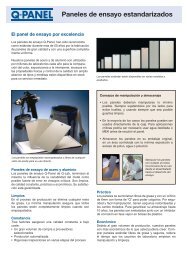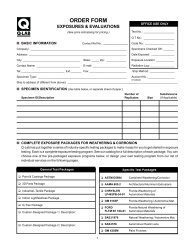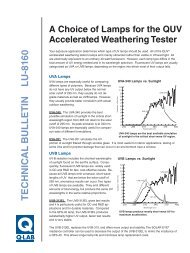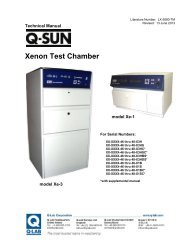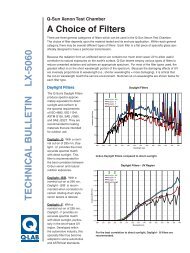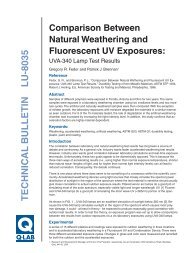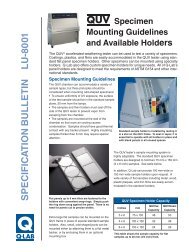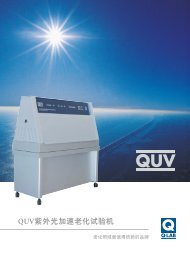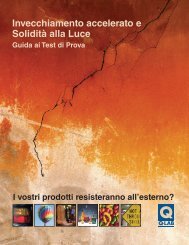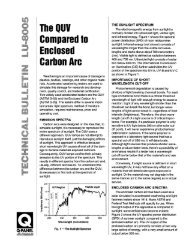LU-8031 - High Irradiance UV Testers - Q-Lab
LU-8031 - High Irradiance UV Testers - Q-Lab
LU-8031 - High Irradiance UV Testers - Q-Lab
Create successful ePaper yourself
Turn your PDF publications into a flip-book with our unique Google optimized e-Paper software.
<strong>High</strong> <strong>Irradiance</strong> for Faster Results<br />
The programmable, automatic irradiance control<br />
system allows the operator to choose a higher than<br />
standard level of irradiance for <strong>UV</strong> exposure tests.<br />
For many materials, this results in faster degradation<br />
and therefore shorter test times.<br />
It is widely recognized the <strong>UV</strong>A-340 lamp is a more<br />
realistic simulation of sunlight than the <strong>UV</strong>B-313<br />
lamp. 3,4 Since its introduction, most of the plastics<br />
industry has switched to the <strong>UV</strong>A-340 because it<br />
gives more realistic results. However, in spite of its<br />
limitations, a large number of coatings researchers<br />
continue to use the <strong>UV</strong>-B lamps because they give<br />
faster results. With the programmable controller,<br />
the <strong>UV</strong>A-340 can now be operated at higher irradiance<br />
levels to speed up test results. Figure 2<br />
shows <strong>UV</strong>A-340 lamps at various irradiance levels,<br />
compared to sunlight.<br />
The recommended maximum increase over typical<br />
G53 irradiance is 75%. Even though lamps are<br />
capable of higher intensity levels at full power, it is<br />
not recommended that tests be run at levels higher<br />
than 1.75x normal. There must be some excess<br />
power available to maintain the desired set point<br />
and account for such things as lamp aging and other<br />
factors which reduce the maximum irradiance<br />
potential. It should be noted that lamps operated at<br />
higher than normal irradiance will have a proportionally<br />
shorter useful life span.<br />
Exposure Results for Various<br />
Polymers<br />
The programmable, automatic irradiance control<br />
system allows the operator to choose a higher than<br />
standard level of irradiance for <strong>UV</strong> exposure tests.<br />
For many materials, this results in faster degradation<br />
and therefore shorter test times.<br />
It is widely recognized the <strong>UV</strong>A-340 lamp is a more<br />
realistic simulation of sunlight than the <strong>UV</strong>B-313<br />
lamp. 3,4 Since its introduction, most of the plastics<br />
industry has switched to the <strong>UV</strong>A-340 because it<br />
gives more realistic results. However, in spite of its<br />
limitations, a large number of coatings researchers<br />
continue to use the <strong>UV</strong>-B lamps because they give<br />
faster results. With the programmable controller,<br />
the <strong>UV</strong>A-340 can now be operated at higher irradiance<br />
levels to speed up test results. Figure 2<br />
shows <strong>UV</strong>A-340 lamps at various irradiance levels,<br />
compared to sunlight.<br />
The recommended maximum increase over typical<br />
G53 irradiance is 75%. Even though lamps are<br />
capable of higher intensity levels at full power, it is<br />
not recommended that tests be run at levels higher<br />
than 1.75x normal. There must be some excess<br />
power available to maintain the desired set point<br />
and account for such things as lamp aging and other<br />
factors which reduce the maximum irradiance<br />
potential. It should be noted that lamps operated at<br />
higher than normal irradiance will have a proportionally<br />
shorter useful life span.<br />
Figure 2 Figure 3<br />
<strong>UV</strong>A-340 at Different Intensities<br />
Acrylic Yellowing<br />
<strong>Irradiance</strong> W/m /nm<br />
1.5<br />
1<br />
0.5<br />
Intensified<br />
1.75x<br />
<strong>UV</strong>A-340<br />
Typical <strong>Irradiance</strong><br />
Reduced to .35<br />
Noon Summer<br />
Sunlight<br />
Gloss<br />
100<br />
80<br />
60<br />
40<br />
20<br />
0.83<br />
Material: Epoxy Coating (gray)<br />
Test Conditions:<br />
Q<strong>UV</strong>/se<br />
Lamp: <strong>UV</strong>A-340<br />
<strong>Irradiance</strong>: 1.35 & 0.83 W/m2/nm @ 340nm<br />
Cycle: <strong>UV</strong> Only<br />
Temperature: B.P. 50C<br />
0<br />
270 290 310 330 350 370 390<br />
Wavelength (nm)<br />
1.3<br />
0<br />
0 500 1000 1500 2000 2500<br />
Hours Q<strong>UV</strong>/se Exposure



